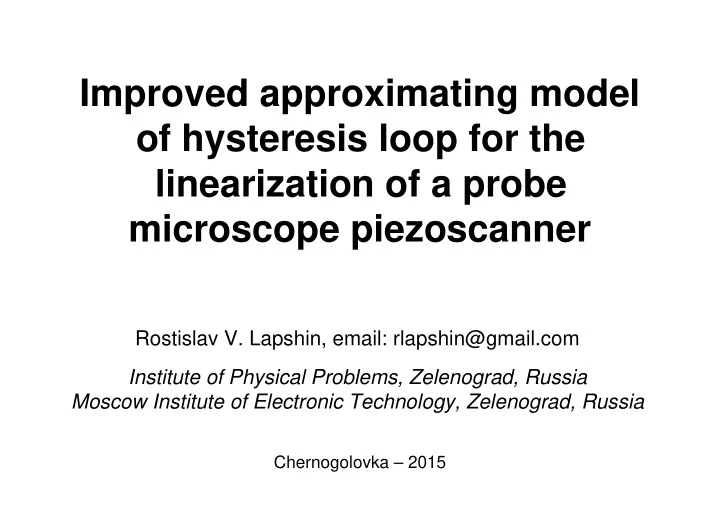

Improved approximating model of hysteresis loop for the linearization of a probe microscope piezoscanner Rostislav V. Lapshin, email: rlapshin@gmail.com Institute of Physical Problems, Zelenograd, Russia Moscow Institute of Electronic Technology, Zelenograd, Russia Chernogolovka – 2015
Abstract The suggested model covers most of the known types of symmetrical hysteresis loops, and allows for the building of smooth, piecewise-linear, hybrid, mirror- reflected, inverse and double loops. The improvement introduces phase shifts ∆ α 1 , ∆ α 2 , ∆ α 3 into the existing model. The phase shift ∆ α 1 makes it possible to change the loop tilt at the split point. The phase shifts ∆ α 2 , ∆ α 3 allow for continuously changing the loop curvature. The model is simple and intuitive; it permits quickly creating hysteresis loops of a required type and easily defining their parameters. The relative error in approximating a hysteresis loop is about 1%.
Parametric equation of a family of hysteresis loops ( ) x a m b n α = α + α cos sin , x ( ) y b α = α sin , y where α is a parameter ( α =0…2 π ); a is x coordinate of the split point; b x , b y are the saturation point coordinates; m is an integer odd number ( m =1, 3, 5, …) defining the curvature of the loop; n is an integer defining the type of the hysteresis loop (with n =1, the “Leaf” loop type is formed; with n =2 – the “Crescent”, and with n =3 – the “Classical”)
Introduction of phase shifts ∆ α 1 , ∆ α 2 , ∆ α 3 ( ) x a c m b c n α = α + ∆ α + α + ∆ α cos ( ) sin ( ), x 1 2 ( ) y b α = α + ∆ α sin( ), y 3 c b a , c are corrected where x parameters of a , b x The phase shift ∆ α 1 allows tilting a hysteresis loop at the split point a
Effect of the phase shifts ∆ α 2 , ∆ α 3 The phase shifts ∆ α 2 and ∆ α 3 provides a continuous change of the loop curvature
Additional capabilities of the model Double loops α α π rnd rnd x x b π π α = α − − + − 2 2 ( ) 2 ( 1 ) ( 1 ) , d x 2 α α π rnd rnd y y b π π α = α − − + − 2 2 ( ) 2 ( 1 ) ( 1 ) , d y 2 where rnd() is a function rounding to the nearest integer
Piecewise-linear loops The parameter α takes values from 0 to 2 π with step 2 π / k , where k is an even integer ( k ≥ 4) k =12 k =8
Piecewise-linear loops built by means of trapezoidal pulses ( ) x a b c m c n α = α + ∆ α + α + ∆ α trp ( ) trp ( ), c x s 1 2 ( ) y b α = α + ∆ α trp ( ), y s 3 where trp are trapezoidal pulses (trp c ( α )=trp s ( α + T /4), T is a period)
Examples of approximation of real loops experiment existing model improved model Approximation error is about 1%
Areas of application • Linearization of piezoceramic scanners and manipulators • Linearization of magnetic and magnetostrictive scanners and manipulators • Simulation of instruments that include hysteresis elements
References 1. R. V. Lapshin, Analytical model for the approximation of hysteresis loop and its application to the scanning tunneling microscope, Review of Scientific Instruments , vol. 66, no. 9, pp. 4718-4730, 1995 (www.niifp.ru/staff/lapshin/en/#articles) 2. Supplementary materials: R. V. Lapshin, Hysteresis loop, Mathcad worksheet, 2015 (www.niifp.ru/staff/lapshin/en/#downloads) 3. S. A. Agafonov, V. A. Matveev, Dynamics of a balanced rotor under the action of an elastic force with a hysteresis characteristic, Mechanics of Solids , vol. 47, no. 2, pp. 160-166, 2012
Appendix Formulae for calculation of the corrected parameters ( ) ( ) a n b n ∆ α − ∆ α − ∆ α − ∆ α cos sin a c = x 2 3 2 3 , ( ) ( ) ( ) ( ) m n m n ∆ α − ∆ α ∆ α − ∆ α + ∆ α − ∆ α ∆ α − ∆ α sin sin cos cos 1 3 2 3 1 3 2 3 ( ) ( ) a m b m ∆ α − ∆ α + ∆ α − ∆ α sin cos b c = x 1 3 1 3 ) . ( ) ( ) ( ) ( x m n m n ∆ α − ∆ α ∆ α − ∆ α + ∆ α − ∆ α ∆ α − ∆ α sin sin cos cos 1 3 2 3 1 3 2 3
Recommend
More recommend